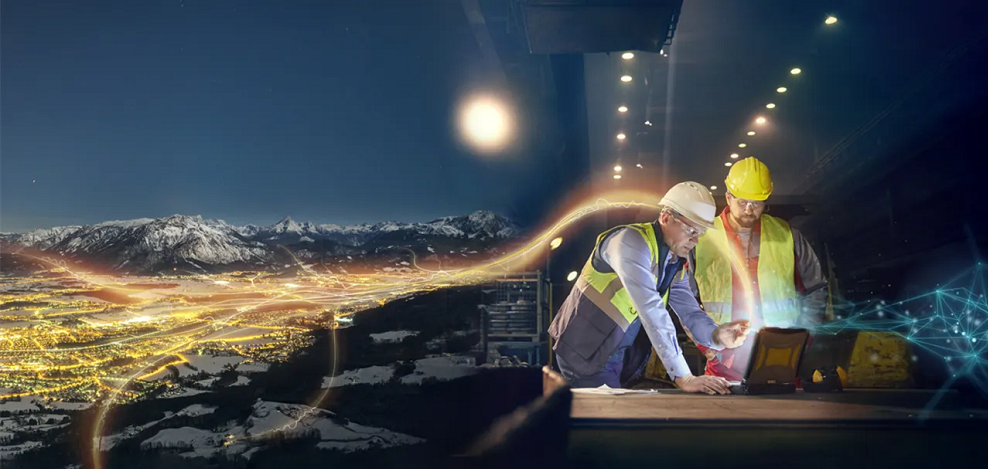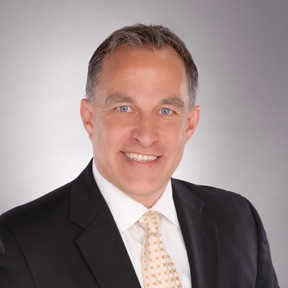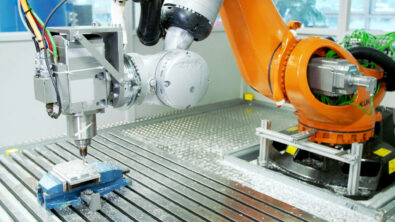Energy Transformation – Unpacking Siemens Digital Lifecycle Excellence – Transcript ep. 1

Siemens Digital Lifecycle Excellence is impacting the Energy Industry. The industry gains substantially from digitalizing its operations. In addition, Siemens’ Xcelerator software suite addresses and solves data management issues.
In this first podcast of the Energy Transformation series, John Lusty, Global Industry Marketing Leader at Siemen Digital Industries Software, speaks with John Nixon, Senior Director of Energy and Utilities at Siemens. This series introduces the new Digital Lifecycle Excellence, discussing Siemens’ history as a software company, our philosophy and how we take a lifecycle approach to enterprise data management.
Check out the transcript below or listen to the audio podcast version.
Read the transcript

John Lusty: Hey everybody, I’m John Lusty with Siemens Digital Industries Software. And with me here today is John Nixon. Say hello, John.
John Nixon: Hi, I’m John Nixon with Digital Industries Software.
John Lusty: So, first, we’ll introduce ourselves. So, as mentioned before, my name is John Lusty. I’m the Industry Lead for Energy and Utilities Industry Marketing at Siemens DISW. I live in Calgary, Alberta. I have over 25 years of experience in the Energy and Utilities industry. I spent it in facilities about the first third, working in and around steam and cooling water systems. And the last two-thirds, working with customers in the Energy and Utilities industry, helping them digitalize their plants. John, do you want to give a quick introduction of yourself?

John Nixon: Sure. I’m John Nixon. I’m with Digital Industries Software as well. I’m the Lead for Global Strategy. Almost, I guess, 30 years in the industry, working in Eastern Europe, Central America, and China, and excited about where we’re taking Siemens DISW, Digital Industries Software, into the Energy and Utilities industry.
John Lusty: So, welcome, everybody, to our first podcast. We will talk to you about what we’re doing with this digital energy podcast, the process we want to follow, and what you could get out of it? So, we’re here today because we want to introduce our new Digital Lifecycle Excellence podcast series, which will have four short episodes of about 15 to 20 minutes each. We want to walk you through a process where we tell you about Siemens as a software company because many people don’t realize that Siemens produces software. We are a very significant-sized software company. We want to tell you about our philosophy on taking a lifecycle approach to enterprise data management. We want to tell you a bit about our Xcelerator platform; what does that mean. And then, what is Digital Lifecycle Excellence? Why are we talking about this on today’s podcast? And what is a digital thread? And what we want you to get out of this is to provide you with a better understanding of Siemens Digital Industries Software; what is our Digital Lifecycle Excellence approach to data management in the Energy and Utilities Industry? So, let’s take it from there. John, does that sound like an excellent way to set this up?
John Nixon: That sounds great. I’m ready to go.
John Lusty: So, how are we going to do this? So, most people are familiar with Siemens as a corporate entity; most know us as Siemens AG. Many people probably think of us providing control systems, automation, significant equipment like turbines, etc. But Siemens is a network of organizations. And John and I work for a company called Digital Industries, and within that, a business unit called Digital Industries Software. We’re a multi-billion dollar organization – so, a very, very large software company, but typically in the background. So, many of the assets that we use in our facilities, the things we use in our day-to-day lives, were produced, designed, optimized, and perfected0 for manufacturing using Digital Industries Software. So, we are a business unit of Siemens AG. John, do you want to talk about how we’re divided into a group of eight industries?
John Nixon: Yeah, absolutely, my pleasure. So, when you talk about Energy and Utilities as part of Digital Industries Software, about eight segments are aggregated together in Energy. So, we’ve got oil and gas production, pipelines and storage, for example, power gen and utilities – our energy segment. In the chemicals area, we also deal with refining chemicals and polymers. With materials, we look at glass, cement, rubber, and then, of course, upstream, mining and metals. And then we also, within Energy and Utilities, touch on AEC – Architect, Engineer, Construct – that area of infrastructure and water and wastewater.
John Lusty: Thanks, John. And I think some of the advantages we bring to Energy and Utilities customers is that we’re also exposed to other industries. We’ve got business units within our company, staffed by people like John and myself. For decades, they have been in the industry of marine, aerospace, defense, high-tech semiconductors, automotive transport, aerospace, etc. So, we cover the gamut of industries. And each industry segment has specific strengths that it has learned over many years. So, for example, aerospace and defense, for obvious reasons, have developed deep expertise and verification management and making sure that requirements of what they’re going to be producing perform as expected each time. And so we’re very good at cross-pollinating industry groups and taking best practices and bringing them across.
So, for years, Energy and Utilities have operated under a focus on what’s being used in the industry today. We didn’t look to the left and right as much as we see today. But, in the last few years, some of the industry dynamics have opened the industry’s eyes to “Hey, wait a sec. If some industries are doing change management better than we are, why don’t we incorporate what they’re doing here?” Because at the end of the day, data behaves the same way across all these industries. So, it makes our approach to the market unique, but it reduces the risk for the clients, and that’s what people like. Our philosophy at Digital Industries Software is based on a lifecycle approach to data management; industries such as automotive transportation produce discrete products, discrete assets, that design and decommission them; unlike what we do in Energy and Utilities, where our customers may operate facilities for decades, they’re very, very long life. But at the same time, we’ve grown as a company to recognize the strengths in capturing the data and documentation that supports from the initial conceptual design of a product, an asset, or a project right through its entire lifecycle, through design, through construction, through commissioning, handing over to operations, doing operations and maintenance, and the eventual decommissioning. So, that lifecycle approach is typically newer to the Energy and Utilities industry. Still, it provides a great model from an enterprise data management perspective regarding how to manage your data. John, do you wanna [sic] add at all to the lifecycle discussion?
John Nixon: You’re talking about a lifecycle approach to Energy and Utilities. So, if I look back at my pedigree, I worked for a pipeline maintenance company for many years. There was an event in 2010 that occurred; there was an explosion in Northern California in San Bruno that killed eight people and caused billions of dollars worth of damage. It was a 30-inch natural gas line that ruptured within a neighborhood. When we did a forensic analysis of the welds for that pipeline, we found no lifecycle associated with it in the company. You couldn’t validate the material condition that was used during the weld. You couldn’t validate the weld procedure, the people that did the welds.
Was this an operator issue? Was it a material issue? How many other welds had been compromised? So, I quickly look at why lifecycle is essential in my career. You want to maintain a lifecycle from concept through operations to prevent these issues. So, you’re tracking the procedures, data gathered, material quality, and so forth as you go through the installation, assembly, construction, commissioning, and operations. And then, just as important, if you do have issues, how do you quickly forensically go back to the lifecycle of these assets to understand why you had a problem to prevent them from [reoccurring in] the future. So, for me, lifecycle has both a quality issue; it’s got a safety issue and an environmental issue.
And as you know, John Lusty, ESG – Environmental, Sustainability, and Governance, or sometimes referred to as Environmental, Social and Governance – are significant issues right now. And I see this as a profound, distinct issue within Energy: to make sure that we have a lifecycle from concept through operations to prevent and prescriptively address operations and maintenance. And then, as importantly, when we do have an issue, we learn from it as we go forward.
John Lusty: I think what’s interesting about that example, John, the San Bruno example and capital assets, if you look at the nature of business models that are involved in an asset like that, from the equipment OEMs, those that produce gas or liquids pipeline, or maybe they’re having compressors, perhaps they’re making pumping stations right down to the PLCs and the individual instruments. There are the equipment suppliers that supply a capital asset; you’ve got engineering companies, EPCs (Engineer, Procure, Construct) that manage a project that follows a company specification, specify that project, design the facility or the pipeline, and hand it over to the owner-operator. And then you’ve got the owner-operator that needs to manage that data for decades. So, the tools that the different industries, different business models use are various, depending on the task they’re challenged to deliver on, whether it’s mechanical CAD for somebody producing compressors, whether it’s project execution systems for an EPC managing multi-discipline design groups, to bringing it all together on a project, to an owner-operator who is consuming all of that data and needs to organize it, make it available to their knowledge, to their engineering staff, to the maintenance staff, and make it available.
So, it cries out for a way to consolidate systems of systems, bring individual applications from this diverse network, get all of the output with a high level of intrinsic value within that data, and consolidate it. From a Siemens perspective, every industry – whether you’re designing an aircraft carrier to a cogeneration plant – has similar problems. So, as a result, Siemens has developed a toolset that we call Xcelerator. And we talked a bit at the beginning about the Xcelerator toolset, the ideal solutions that a customer would use to manage all that data that needs to be highly comprehensive to allow them to do what they need to do; it needs to be open and flexible. It has to support open standards so that information can flow from each discipline to each discipline, bridge the gaps between silos, eliminate the Excel spreadsheets currently filling those gaps, and trap that value so the owner-operator can’t ultimately reuse it. So, the Siemens platform is called Xcelerator. It’s a broad toolset. We don’t need to get into that today; there’s lots of information on the website.
But they are a toolset that supports business operations, depending on the industry and the business model that a company is maintaining. So, at the end of the day, whether you’re an owner-operator in the oil and gas industry or power generation, or you’re designing turbines that are being sold into those industries, or you’re an EPC; we want to be able to capture that output and make it available to the part of this equation that has the most complicated task, which is the owner-operator. So, Xcelerator, the Siemens platform of solutions, delivers on that. And within that, in the Energy and Utilities group, we’ve created digital threads. Digital threads are solution sets that work together comprehensively and flexibly. They can be personalized to help customers, whether they’re owner-operators or OEMs, allow them to deliver on their business model. So, the first one that we’ve rolled out is Digital Lifecycle Excellence, which we talked about earlier. Digital Lifecycle Excellence describes the lifecycle approach to technical enterprise data management, providing business value by consolidating information, validating information, and making that information available to your knowledge workers. It becomes the foundation of all future business requirements and supports assets. John talked about the need to deliver on our ESG challenges as an industry as we navigate energy transition, make that information available for workers on capital projects, and help guide the crazy market volatility that we’ve been going through. John, you spent a lot of time around significant assets. I remember you telling me a story about where you had to manage massive amounts of – I think it was weld information that had to be consolidated. Do you want to talk about that a little bit?
John Nixon: What you’re talking about is a very, let’s say, day-to-day challenge with asset management. You’ve got people in the field, men and women are going in the area, they’re visually inspecting assets as they perform. You’re gathering that data; you’ve got sensor data that you’re gathering. You’ve got an immense amount of data that’s coming at you. How do you collect all of that? How do you manage all of that? How do you analyze all of that and determine where your trouble is? In the past, when I was in the field just a few years ago, we were still using 3-ring binders and paper to document what we had observed in the area. We might be doing a hydro test; we may be doing an x-ray; we may be doing ultrasonics – there’s some testing always going on in the field on operating assets, and then that data is recorded manually. So, the demand to drive and bring that data back and have the digital twin match the physical reality in the field is a preeminent challenge. And so the beauty of what we’ve done with Xcelerator, which is our way of communicating our entire suite of solutions, gathering that data, analyzing that data and prescriptively looking at what should be done to mitigate issues – that’s Xcelerator for us in Energy. And when you look at Digital Lifecycle Excellence, Mr. Lusty, if I can take two steps back, what is our species doing right now?
We are decarbonizing our entire supply chain as a planet. There’s no planet B. There’s no plan B for this planet. So, we’re focusing on our consumption of oil and gas, how we process mined materials, entire supply chains are looking at their carbon footprint and the waste they generate. Just as a quick heads up, 24% of all solid waste is produced from the construction industry, even in the United States. And I read a report the other day that said by 2024, 2.2 billion tonnes of solid waste will be generated in construction projects. And so, that demands that as a species, we take a more detailed lifecycle approach to how we’re mining, refining, applying, and developing all this infrastructure that keeps us moving forward as a species – that demands that we have digital lifecycle excellence throughout the entire process. When you think about lifecycle, you start with a concept and design. We need to design out of the development and the delivery in the field, all of this carbon, all of this waste. And then where we can’t develop all of that carbon and waste out of our efforts when we get to construction, we minimize that carbon and waste development, we move into operations of maintenance. Now we optimize to, again, reduce our carbon, reduce our waste that’s developed. You can’t do that if you don’t have a lifecycle from concept through operations for that effort.
John Lusty: Excellent, John. It describes how the data that supports an organization has tremendous value. So, yes, like every asset, it needs to be maintained. But it forms the foundation for all of the innovation challenges that businesses in this industry will have to manage in the years and the decades to come. And hey, we don’t have the answers to many of them right now. But, still, our knowledge workers armed with the correct tools and with all of the assets, all of that value from inception, from the cradle to the grave, if you will, end-to-end in the lifecycle; we need to make that available to those knowledge workers so that they’re best positioned to be able to solve these challenges such as the energy transition.
John Nixon: And John, when you talk about knowledge workers. Imagine, if you will, the current generation of workers that we’re recruiting and bringing into this industry; they were raised on Xbox and PlayStation and iPhones. The bar has been raised with their anticipation of the digital frontier that they’ll find in the energy industry. And so the expectation is they’re going to walk into an industry that needs to be at the level they were raised. And so there’s a specific lifecycle view, a digital twin and a digital lifecycle view on this industry that customers, for us, and companies in this industry need to have to attract that talent. So, for example, a construction company here in the Western Hemisphere that we’ve been talking to told us, “We’re having trouble attracting talent because they see working for us is like stepping back into a time machine 10 or 20 years.”
And so we’ve made considerable investments in advancing what our technology investments are at this company as we move to attract that talent; in constructions [it does] not seem like, for example, Silicon Valley in California. So, think about what’s going on, John; in the energy industry, we’re in the 90s now for crude oil; we’re seeing growing demand in consumption in Cushing, Oklahoma, and the levels of oil storage are at an all-time low. So, we’re starting to see some severe constraints in this environment. At the same time, we’re decarbonizing as a species. What does this do? This requires that number one if recruitment is becoming difficult. Yet, Energy and demands are increasing, and we’re starting to see scarcity of commodities – it means we’ve got to make digital investments. We have to make those investments because the bottom line is we’ve got to keep the lights on, we’ve got to keep our cars moving. That means we’ve got to have fuel, we’ve got to have electricity, and we’re going to have to do it with a scarce environment for talent that screams digitalization – that means we’ve got to have a lifecycle approach to how we address Energy.
John Lusty: Well, and you have to have tools that will track those you users too, because like it or not, the industry is competing against the best in the business: the Googles, etc. So, if we’re going to attract the workers to replace retirees at an increasing rate until 2030, we need to offer them the same tools that organizations like NASA and SpaceX are using, but we’ve got to do it in oil and gas. So, it’s interesting because maintaining the supply of Energy is about maintaining life. We can’t do anything without Energy. So, it’s imperative to our society, as well as to our industry. So, John, we’ve probably run our course on this podcast. We wanted to keep it to about 20-25 minutes, so why don’t we wrap up. Just for everybody to review, what we wanted you to get from this podcast was to understand Siemens Digital Industries Software better, what we’re doing, the Digital Lifecycle Excellence approach to data management, Energy and Utilities, and why it is a value? This is a pretty quick introduction, but we hope you found this interesting and helpful and understand more than you did a few minutes ago about what we’re doing at Siemens, Xcelerator, and Digital Lifecycle Excellence.
So, for more information, check out the Digital Lifecycle Excellence webpage; you can find it at www.siemens.com/dle. You can learn more by watching an on-demand webinar and downloading an ebook; you can look at an infographic on the subject or subjects related to that. Finally, it would help if you watched our second podcast, where we will be drilling into low-code application development and how it’s being used today in Energy and Utility organizations.
Also, feel free to connect with John Nixon and me, John Lusty, on LinkedIn, as we’re passionate about what we’re doing. And we’ll help you wherever we can as you progress through your digital journey and that of your enterprise. So, hey, John, thank you very much for joining us today. This has been a blast. And for everybody, three more podcasts are coming where we’re going to get more specific on new topics; the next one is Requirements Management. So, we’d like to thank you for joining us today.
Xcelerator, the comprehensive and integrated portfolio of software and services from Siemens Digital Industries Software, helps companies of all sizes create and leverage a comprehensive digital twin that provides organizations with new insights, opportunities and levels of automation to drive innovation.
For more information on Siemens Digital Industries Software products and services, visit siemens.com/software or follow us on LinkedIn, Twitter, Facebook and Instagram. Siemens Digital Industries Software – Where today meets tomorrow
Related links:
Energy Transformation podcast 02
Energy Transformation podcast 03


